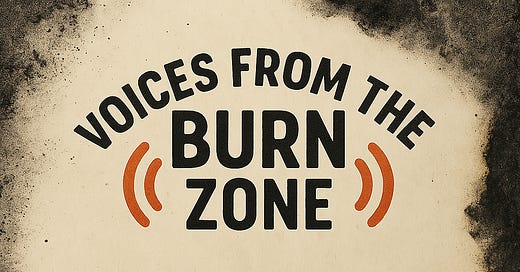Unprotected on the Frontlines: The Hidden Health Crisis After the Eaton Fire
Firefighters, cleanup crews, utility workers, and military personnel faced toxic exposure without clear safety protections
In the months following the Eaton Fire, multiple news investigations have revealed a disturbing reality. The very people tasked with responding to the disaster and cleaning it up are now suffering the consequences of toxic exposure. Firefighters, day laborers, utility workers, and military personnel were sent into contaminated zones without consistent use of personal protective equipment.
Firefighters’ Health at Risk
Pasadena firefighters who battled the blaze in January are now reporting ongoing symptoms. These include burning eyes, black phlegm, vomiting, and severe fatigue. Blood tests have shown elevated levels of carcinogens, heavy metals, and other toxins. According to Fire Chief Chad Agustin, this was not a typical wildfire. It involved the burning of thousands of structures, releasing lead, asbestos, and other hazards into the air.
The department is now working with national experts and the University of Arizona to study long term health effects.
Cleanup Crews and Day Laborers Lacked Protection
A Los Angeles Times investigation found that many cleanup workers were operating without gloves, respirators, or Tyvek suits. These laborers—many of them undocumented or working under informal contracts—were sent into toxic conditions with little to no training or oversight. Despite state regulations requiring protective gear, few contractors enforced them.
Gaps in Oversight and Safety Enforcement
NBC Los Angeles reported that fire recovery crews faced critical safety risks due to poor oversight. With unclear hiring structures and limited enforcement, many workers were exposed to hazardous materials without adequate safeguards. Some had no idea what they were breathing in.
The Bigger Picture
I stopped looking because I could not witness it any longer. I kept telling anyone who would listen. Those are young brown men without protection. They are going to die horrible deaths. They will leave any family they have behind because the government decided not to mitigate any of this. That includes the Army Corps of Engineers, the 2,500 National Guard members, and all the utility workers who were sent in without protection.
I saw them too. Utility crews digging through ash, walking into burned structures, working in contaminated air. No respirators. No suits. Sometimes not even gloves.
I witnessed some of these young men and women working without any protective gear. No masks. No suits. No visible safeguards.
So it raises the questions:
Were they given proper hazard briefings?
Were they offered voluntary blood testing or long term medical tracking?
Who is accountable for occupational safety compliance during post fire deployments?
This is not just about missed protocols or ignored checklists. These are lives on the line. From first responders to day laborers to utility crews and military personnel, the people on the frontlines of disaster response are facing long term health consequences without clear protections, guidance, or recourse.
We must demand a stronger safety net for those who walk into danger to protect and rebuild our communities.
Additional Reading:




